
Charunagari is a script for Sanskrit, designed by Punya Pranava Pasumarty to be simple to write and read, especially compared to the other scripts used currently to transcribe Sanskrit. Also, Charunagari is a script designed exclusively for Sanskrit, although it may be used for other languages that share the phonetic inventory of Sanskrit.
Charunagari is a syllabic alphabet, much like most South/Southeast Asian scripts. It takes inspiration and design cues majorly from Brahmi, Nandinagari, Devanagari, Kannada, Tamil and Purbi Nagari (Bengali / Eastern Nagari) scripts. The following are the syllabic letters (i.e. consonants with inherent ‘ʌ’ sound) used in Charunagari, labelled with equivalents in Devanagari and IPA (shown without the inherent ‘ʌ’ for convenience).
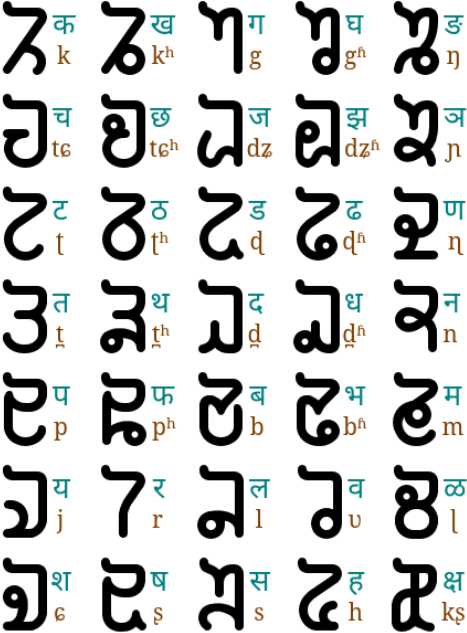
All the letters are designed to have a horizontal top-line (occasionally having a cusp in the middle) with an upturned end at the top-left corner. Every letter is written starting at this upturned corner and completed using a single continuous stroke.
Apart from the letters shown above, there is a ‘null’ letter which has no consonant sound. On its own, the null letter assumes the sound of its inherent ‘ʌ’, but different marks can be placed above, below and/or to its right to change the vowel sound.These vowel marks can also be placed on other letters to change their inherent ‘ʌ’ sound to the mark’s respective vowel sound. The following image shows the null letter (labelled as ‘ʌ’) and all vowel marks in Charunagari (with equivalents in Devanagari and IPA):
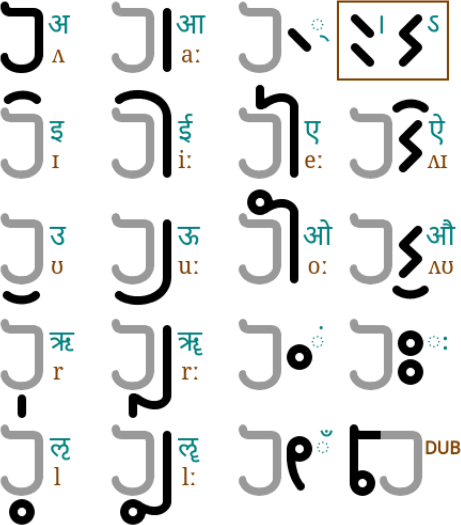
The vowel marks have been shown on a greyed-out null consonant, which implies that the latter can be replaced with any other letter. The mark labelled as ‘DUB’ is used to double the letter it is attached to albeit it is never actually used on the null letter. The mark labelled as [ ं ] is the anusvara mark. When the anusvara occurs atthe end of a word, it assumes the sound of ‘m’ [ म् ]. The mark labelled as [ ँ ] is the chandrabindu, which nasalizes the vowel sound of the letter it is connected to. The mark labelled as [ ः ] is the visarga. The mark labelled as [ ् ] is the halanta, whichis used to remove the inherent ‘ʌ’ of the letter.
The brown box at the top-right of the image shows marks that are not attached to letters. The one on the left is the sentence break mark and the one on the right is the‘avagraha’ mark, used in Sanskrit to indicate disappearance of ‘ʌ’ sound when two words are joined.
Forming consonant clusters is simple in Charunagari. Here, the letters that are to bejoined together are just juxtaposed horizontally, then the upturned corner of each of these letters, other than the first one, is ‘ironed-out’. ‘Ironing out’ involves flattening the upturned corner of the letter and connecting it to the previous letter in such away as to be continuous with the previous letter’s topline:
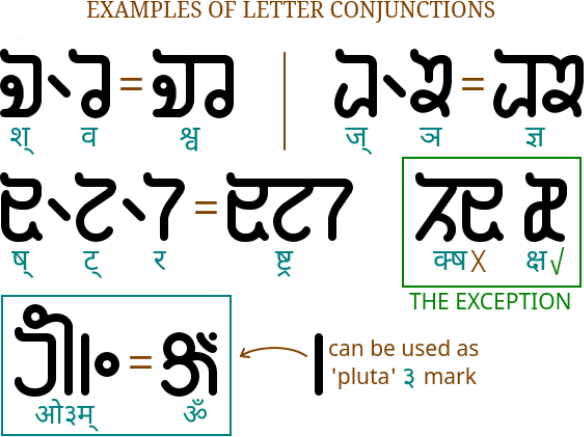
There is one exception to the ironing-out process, as highlighted in the image above. The last letter in the abugida, labelled as ‘kʂ’ is a commonly used conjunct consonant pair in Sanskrit which is often treated as its own letter in the language, so Charunagari has a special glyph for it. This sound can be created by pronouncing ‘k’ and ‘ʂ’ sounds successively, yet instead of just juxtaposing and ‘ironing’ these letters, the special glyph for ‘kʂ’ is used in Charunagari. In principle, this letter is similar to what ‘X’ is in English. This is the only exception to the ironing-out process in Charunagari.
At the bottom of the image is shown the Charunagari symbol for OM [ॐ] and how it can be written out with vowels and marks. As seen here, the vertical line mark, normally used for the ‘aː’ vowel, can also be used as the pluta vowel extension markwhen used in addition to any long vowel mark.
Charunagari has its own set of numerals. The shapes of the numerals have taken inspiration from the numerals of most scripts of India. However, they all have been stylized to have a bottom-line, similarly to how the letters all have a top-line. When several digits come together to form a number, they juxtapose and their bottom-lines “iron out” like how the letters discussed above combine to form conjunct consonants. Decimal expansions juxtapose separately from the integer part of the number. The method of representing decimal expansions is explained in the image below, with an example:
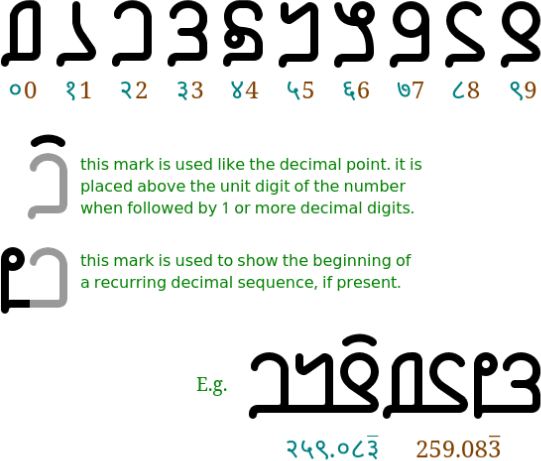
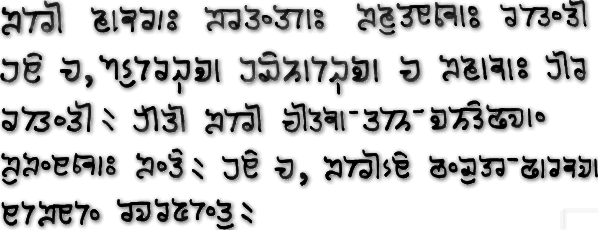
सर्वे मानवाः स्वतन्त्राः समुत्पन्नाः वर्तन्ते अपि च, गौरवदृशा अधिकारदृशा च समानाः एव वर्तन्ते। एते सर्वे चेतना-तर्क-शक्तिभ्यां सुसम्पन्नाः सन्ति। अपि च, सर्वेऽपि बन्धुत्व-भावनया परस्परं व्यवहरन्तु।
Sarvē mānavāḥ svatantrāḥ samutpannāḥ vartantē api ca, gauravadr̥śā adhikāradr̥śā ca samānāḥ ēva vartantē. Ētē sarvē cētanā-tarka-śaktibhyāṁ susampannāḥ santi. Api ca, sarvē´pi bandhutva-bhāvanayā parasparaṁ vyavaharantu.
All human beings are born free and equal in dignity and rights. They
are endowed with reason and conscience and should act towards one another
in a spirit of brotherhood.
(Article 1 of the Universal Declaration of Human Rights)
Download details of the Charunagari script (PDF)
Information about Sanskrit | Phrases | Numbers | Tower of Babel | Writing systems for Sanskrit: Devanagari, Bhaiksuki, Brahmi, Galik, Grantha, Gupta, Kadamba, Kharosthi, Nandinagari, Sharda, Siddham, Thai, Tibetan
Bhāratalipi Unified Indian Script (BLUIS), Charunagari, Deccan Lipi, Devadeshi, Ethiofarsi, Españabugida, Farsi Alefbet, Featural Lojban Abjad, Haruf-e-Tana, Palimukhi, Neobrahmi, SEAscript, West Eurolex
Constructed scripts for: Ainu | Arabic | Chinese languages | Dutch | English | Hawaiian | Hungarian | Japanese | Korean | Lingala | Malay & Indonesian | Persian | Tagalog / Filipino | Russian | Sanskrit | Spanish | Taino | Turkish | Vietnamese | Welsh | Other natural languages | Colour-based scripts | Tactile scripts | Phonetic/universal scripts | Constructed scripts for constructed languages | Adaptations of existing alphabets | Fictional alphabets | Magical alphabets | A-Z index | How to submit a constructed script
[top]
You can support this site by Buying Me A Coffee, and if you like what you see on this page, you can use the buttons below to share it with people you know.

If you like this site and find it useful, you can support it by making a donation via PayPal or Patreon, or by contributing in other ways. Omniglot is how I make my living.
Note: all links on this site to Amazon.com, Amazon.co.uk
and Amazon.fr
are affiliate links. This means I earn a commission if you click on any of them and buy something. So by clicking on these links you can help to support this site.
[top]